
Cologne Cathedral is a Catholic cathedral in Cologne, North Rhine-Westphalia. It is the seat of the Archbishop of Cologne and of the administration of the Archdiocese of Cologne. It is a renowned monument of German Catholicism and Gothic architecture and was declared a World Heritage Site in 1996. It is Germany's most visited landmark, attracting an average of 20,000 people a day. At 157 m (515 ft), the cathedral is the tallest twin-spired church in the world, the second tallest church in Europe after Ulm Minster, and the third tallest church of any kind in the world. It is the largest Gothic church in Northern Europe and has the second-tallest spires. The towers for its two huge spires give the cathedral the largest façade of any church in the world. The choir has the largest height-to-width ratio, 3.6:1, of any medieval church.
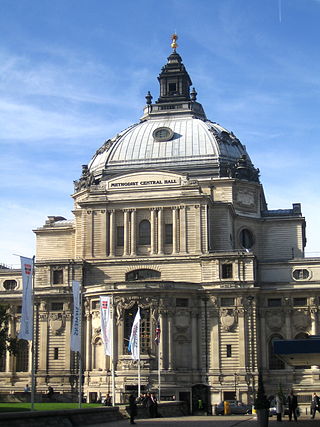
The Methodist Central Hall is a multi-purpose venue in the City of Westminster, London, serving primarily as a Methodist church and a conference centre. The building, which is a tourist attraction, also houses an art gallery, a restaurant, and an office building. It contains 22 conference, meeting and seminar rooms, the largest being the Great Hall, which seats 2,300.

St. Stephen's Cathedral is the mother church of the Roman Catholic Archdiocese of Vienna and the seat of the Archbishop of Vienna, Christoph Cardinal Schönborn, OP. The current Romanesque and Gothic form of the cathedral, seen today in the Stephansplatz, was largely initiated by Duke Rudolf IV (1339–1365) and stands on the ruins of two earlier churches, the first a parish church consecrated in 1147. The most important religious building in Vienna, St. Stephen's Cathedral has borne witness to many important events in Habsburg and Austrian history and has, with its multi-coloured tile roof, become one of the city's most recognizable symbols.

Aachen Cathedral is a Roman Catholic church in Aachen, Germany and the seat of the Roman Catholic Diocese of Aachen.

The Berlin Cathedral, also known as the Evangelical Supreme Parish and Collegiate Church, is a monumental German Evangelical church and dynastic tomb on the Museum Island in central Berlin. Having its origins as a castle chapel for the Berlin Palace, several structures have served to house the church since the 15th century. The present collegiate church was built from 1894 to 1905 by order of German Emperor William II according to plans by Julius Raschdorff in Renaissance and Baroque Revival styles. The listed building is the largest Protestant church in Germany and one of the most important dynastic tombs in Europe. In addition to church services, the cathedral is used for state ceremonies, concerts and other events.
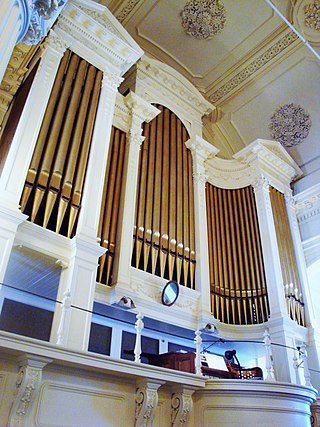
Æolian-Skinner Organ Company, Inc. of Boston, Massachusetts was an American builder of a large number of pipe organs from its inception as the Skinner Organ Company in 1901 until its closure in 1972. Key figures were Ernest M. Skinner (1866–1960), Arthur Hudson Marks (1875–1939), Joseph Silver Whiteford (1921-1978), and G. Donald Harrison (1889–1956). The company was formed from the merger of the Skinner Organ Company and the pipe organ division of the Æolian Company in 1932.
Bernd Alois Zimmermann was a German composer. He is perhaps best known for his opera Die Soldaten, which is regarded as one of the most important German operas of the 20th century, after those of Berg. As a result of his individual style, it is hard to label his music as avant-garde, serial or postmodern. His music employs a wide range of methods including the twelve-tone row and musical quotation.
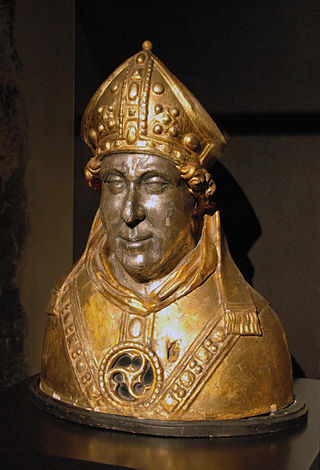
Count Engelbert II of Berg, also known as Saint Engelbert, Engelbert of Cologne, Engelbert I, Archbishop of Cologne or Engelbert I of Berg, Archbishop of Cologne was archbishop of Cologne and a saint; he was notoriously murdered by a member of his own family.
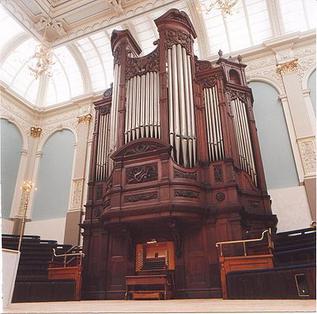
Henry Willis & Sons is a British firm of pipe organ builders founded in 1845. Although most of their installations have been in the UK, examples can be found in other countries.
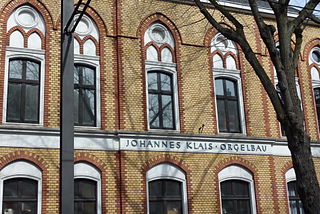
Orgelbau Klais is a German firm that designs, builds and restores pipe organs. It is a family run company, founded in 1882 by Johannes Klais senior and is now run by his great-grandson Philipp Klais. The firm is based in Bonn, Germany, and has completed many large-scale building and restoration projects around the globe in more than a century of organ building.
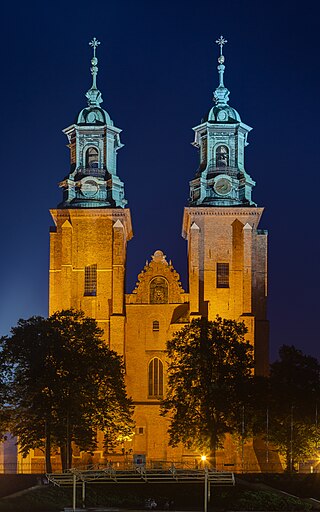
The Royal Gniezno Cathedral is a Brick Gothic cathedral located in the historical city of Gniezno that served as the coronation place for several Polish monarchs and as the seat of Polish church officials continuously for nearly 1000 years. Throughout its long and tragic history, the building stayed mostly intact, making it one of the oldest and most precious sacral monuments in Poland.

The pipe organ is played from an area called the console or keydesk, which holds the manuals (keyboards), pedals, and stop controls. In electric-action organs, the console is often movable. This allows for greater flexibility in placement of the console for various activities. Some very large organs, such as the van den Heuvel organ at the Church of St. Eustache in Paris, have more than one console, enabling the organ to be played from several locations depending on the nature of the performance.

Harald Bode was a German engineer and pioneer in the development of electronic musical instruments.

The Prince-Bishopric of Paderborn was an ecclesiastical principality (Hochstift) of the Holy Roman Empire from 1281 to 1802.
Andrew Emerson Unsworth is an American organist who has served an organist for the Salt Lake Tabernacle since 2007, which includes being an organist for the Tabernacle Choir at Temple Square, which is the principal resident musical organization there.

Dome Pipe Organ, the second largest pipe organ in Latvia, is located in Riga Cathedral. The largest mechanical pipe organ in Latvia is located in Liepāja Holy Trinity Cathedral.

Aloys and AlfonsKontarsky were German duo-pianist brothers who were associated with a number of important world premieres of contemporary works. They had an international reputation for performing modern music for two pianists, although they also performed the standard repertoire and they sometimes played separately. They were occasionally joined by their younger brother Bernhard in performances of pieces for three pianos. After suffering a stroke in 1983, Aloys retired from performing.

Marco Lo Muscio is an Italian organist, pianist and composer, who lives and works in Italy, Europe, Russian Federation and America.

Chur Cathedral, otherwise known as the Cathedral of the Assumption of Mary, is the Catholic cathedral of the diocese of Chur in Switzerland. The episcopal palace of the bishop of Chur is beside the church. The cathedral claims the relics of St Lucius of Britain, said to have been martyred nearby in the late 2nd century. During the Swiss Reformation, the Catholic population of the city were confined to a ghetto enclosed around the bishop's court beside the cathedral. It is a Swiss heritage site of national significance.

The Minoritenkirche or Church of the Immaculate Conception is a Catholic church on the Kolpingplatz in Cologne. Built in the 13th century, it is now used by the Franciscan and the Kolpingwerk social association.



















